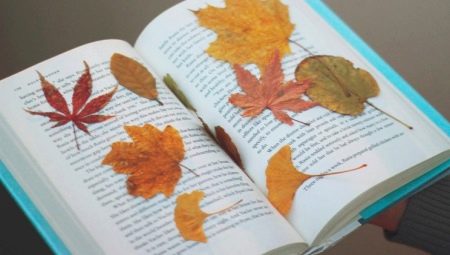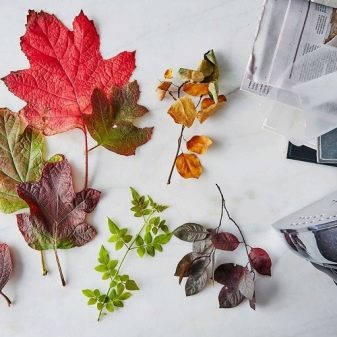How to save leaves for crafts?

Working with natural materials is very interesting and exciting, especially for children. Creating crafts using the gifts of nature allows you to study the world around you, treat it with kindness and respect. Leaves from trees are a convenient material from which you can create a wide variety of crafts. In order to have a specific arsenal of leaves to work in different colors, sizes and seasons, it is important to be able to store them.


Waxing
Beautiful, multi-colored leaves with different shapes, sizes, textures amaze with their diversity. Children and adults can create interesting applications, crafts and paintings from this material. To preserve the leaves for a long time and be able to work with them after a week, a month or more, you need to properly process them. One of the more popular options is waxing. For waxing, you need to prepare:
- leaves;
- a metal container that is no longer needed for cooking;
- wax candle;
- wax paper or clothespins.


To preserve the color of the leaves, it is important to choose a white candle, color options can change the shade of the natural material. To ensure the best result, it is necessary to sort through the assembled products, remove any torn, curled or damaged sheets. If the material at hand is wet, it is necessary to dry or wipe everything before waxing. Once the leaves are ready, you should start working with the wax. You can melt a candle only in a water bath, and not in a container on fire.
When the wax becomes liquid, a leaf is dipped into it 2-3 times to provide a sufficiently dense protective layer. It is important to hold the leaves by the edge of the petiole so as not to burn yourself on the hot substance. Finished leaves in wax are placed on waxed paper, which allows you to freely peel off dried products; any other type of paper will not work for these purposes. An alternative drying method is to hang the natural material in wax on a rope and attach it with clothespins.
Once the wax has completely hardened, you can remove the sheets and put them in a storage location prepared in advance.


Preservation in glycerin
You can preserve autumn leaves for a long time using other methods, one of which is the use of glycerin. This method requires more time and effort, however, it allows you to save not only leaves, but also twigs with foliage, which looks very impressive and can be used in more complex crafts.
To carry out canning with glycerin, you must:
- prepare 500 ml of glycerin;
- pour 2 liters of water;
- pick up the selected and prepared leaves;
- have a hammer with you;
- prepare a colorless dishwashing liquid without foreign smell;
- find a deep container for the procedure.


The canning process boils down to the fact that glycerin is diluted with water and mixed with a few drops of detergent. The branches can be placed in the water before the procedure, but this is not necessary. In order for the prepared liquid to quickly reach the leaves, it is necessary to beat off the edges of the branches with a hammer. After the twigs are prepared, they are immersed in the glycerin solution for 3-5 days so that the glycerin can be completely absorbed into the foliage.
After the expiration date, the natural material is removed from the solution and left to dry completely. Ready-made branches are completely ready for creativity and retain their appearance for a long time.
Using this method allows you to enhance the color qualities of the foliage, making it brighter and more saturated, which has a positive effect on the beauty of the finished craft.


Other storage options
To preserve leaves for crafts, a large number of different options can be used, and their choice should be made depending on the availability of certain improvised means, on the time that can be allocated for work, and on the time frame in which the foliage must be prepared. There are methods that preserve and protect natural materials for a long time, they are suitable for those cases when a craft is made for a gift, and it should retain its appearance as long as possible.
If the leaves are needed for children's applications, then simpler technologies can be used that will give the desired result, but the foliage will deteriorate and crumble over time.


In the book
One of the simplest and most reliable options for how to dry and preserve foliage, twigs and flowers is to use a thick book, inside which natural materials are placed for a long time.
In order for this method to bring the desired result, it is important to sort out the collected leaves, remove those that have holes, rot or other problem areas. For the procedure, it is better to choose old, thick books that are not particularly valuable. During the drying process, juice will be released from the leaves, which will remain on the sheets of the book, coloring them, so you should not use good, and even more expensive, books for drying the herbarium.


In the event that there is a need to place several leaves in one printed edition, it is important to ensure a minimum thickness of 40 pages so that the natural material does not deform and dries evenly. The book should be thick enough - if the pressure is light, there is a risk that the natural materials inside may start to rot.
If it is not possible to find an old thick book, you can use newspapers, keeping them stationary and stable weight in the form of a press. When using good books, you need to protect the pages with sheets of paper or paper napkins, placing leaves from trees between them.
Properly dried products will have a beautiful appearance, retain their structure and become convenient for use in applied arts.


In waxed paper
Thanks to new technologies, it is not necessary to use candles to wax the leaves to preserve them. With the help of waxed paper, you can quickly and efficiently cover the natural material with a protective layer. The preparation process for waxing looks like this:
- selection of foliage;
- preparation of scissors;
- you need an iron for work;
- two waxed leaves are prepared.


For the result to be successful, it is important to carefully prepare the leaves by examining them for moisture and unwanted elements. Wet areas are wiped off, after which all dry products are placed on one sheet of waxed paper and covered with a second. It is necessary to iron this paper for several minutes so that the wax melts from the surface and passes onto the leaves. To get the same result on both sides, it is important to iron the waxed sheet, turn it over and repeat the procedure.
After this process, you need to wait 5 minutes and check the waxed sheets. If they are wet, the procedure must be repeated, if they are dry, the waxing process is over. As soon as the wax is completely transferred to the leaves, using scissors, the excess paper is cut around the natural material. Finished products retain their appearance for a long time.


With glue
The natural material used for crafts and appliqués can be flat if dried in a book or ironed, or retain its original appearance while remaining bulky. To preserve the collected leaves, you can use the most convenient tool in everyday life - PVA glue. Due to its availability, glue is found in almost every home, so it is very convenient to use it to preserve collected natural materials.
The advantages of this method include:
- availability;
- the convenience of use;
- the ability to apply to foliage of any color.

Apart from this, there are a number of disadvantages:
- the finished version may look sloppy;
- the result depends on the quality of the glue;
- leaves in the glue darken over time.
To cover the leaves with glue, it is necessary to prepare a substrate to which the natural material in the glue will not stick. Leaves are laid out on top of the blanks, one side up. Using a brush or a piece of foam rubber, you need to apply glue to the product on one side, wait a little for the top layer to grab, and transfer the foliage to clean paper, and then repeat the procedure. Once the glue is completely dry, the leaves can be used to create voluminous crafts, figures and any other products.










